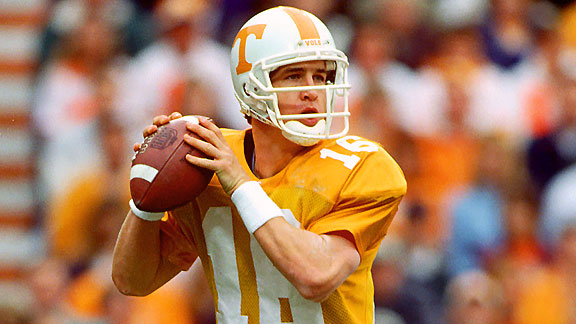A remarkable group: Tennessee's quarterback club of 1993-94
It’s not uncommon for an SEC team to be loaded with talent at one position. Georgia’s tailback tandem of Frank Sinkwich and Charlie Trippi in the 1940s comes to mind, as does Arkansas’ trio of Darren McFadden, Felix Jones and Peyton Hillis in the mid-2000s.
Every now and again, a team will have more NFL-caliber talent at one position than it can get on the field at one time. Such is life in the SEC.
But one group of Tennessee quarterbacks in the early 1990s takes the cake as far as historically good position groups are concerned. In a span of two years, Tennessee claimed four scholarship quarterbacks — three of which were drafted into the NFL (two in the top 3 overall picks), one of which won a Super Bowl, one of which was elected to Congress and one of which logged 2,500 base hits in a 17-year Major League Baseball career. Impressed?
The players we’re referring to are legendary Indianapolis Colts and Denver Broncos quarterback Peyton Manning, equally legendary Colorado Rockies first baseman Todd Helton, former Washington Redskins quarterback and U.S. Congressman Heath Shuler and former Tennessee starting quarterback Jerry Colquitt.
No, not all four players starred at the college level; in fact, only two of the four attempted 100 passes during their careers in Knoxville. And yes, even fewer went on to succeed in the NFL.
But what sets this group apart is the diversity of its collective achievements.
If you’re looking for football success, look no further than Manning. He hails from a historically significant football family, was the No. 1 overall pick in the 1998 NFL draft, holds more NFL passing records than we care to list, won a Super Bowl MVP and is still at the top of his age as he approaches age 40.
If you’re looking for transcendence beyond football, Shuler’s your guy. After throwing for 25 touchdowns against 8 interceptions as a junior in 1993, Shuler rose to the No. 3 overall pick of the 1994 draft. Unfortunately, his pro career lasted only four years as he threw 15 touchdowns against 33 interceptions in 22 career starts.
However, Shuler never let that obstacle slow him down. After falling out of the NFL, he began a new career in real estate and in 2007 was elected to Congress as a representative of his home state of North Carolina’s 11th district. Shuler served three terms and left Congress in 2013.
Were it not for Manning, Helton would easily be the most accomplished professional athlete of the bunch. As a two-sport athlete, Helton was always the furthest from the field of this group of signal callers. He backed up Shuler in ’93, and when Shuler turned the reins over to Colquitt in 1994 Helton remained a backup along with Manning.
Colquitt suffered a season-ending injury seven plays into his first start in ’94, but Manning still managed to leapfrog Helton to start as a true freshman.
Nevertheless, Helton focused on his baseball career, and was drafted eighth overall in the 1995 MLB draft. For context’s sake, there are more than 40 rounds and 1,000 draft picks in each year’s draft, so to be a top 10 overall pick is an even greater honor than it initially seems.
He debuted for the Colorado Rockies, a young expansion franchise at the time, in 1997 and would go on to hit .317 with 369 home runs in 17 Major League seasons. Helton is a fringe Hall of Fame candidate once he’s eligible, and he’s the consensus greatest Rockie of all-time.
Colquitt, despite spending all of seven plays as Tennessee’s starter during his career in Knoxville, was still drafted in the 1995 NFL draft but never lasted in the league. Nevertheless, he rounds out the group as the third quarterback among the bunch to be drafted into the NFL in a span of four years (1994-98).
That’s quite a collective resumé, is it not?
I like to imagine Shuler, Helton and Colquitt walking around campus in 1993, just a bunch of talented 20 year olds loving the effects of stardom on the college experience. They never knew they’d play in five MLB All-Star games or get elected to Congress; they were just a bunch of kids.
Now they’re a group of highly accomplished adults who represent Tennessee at the top of a number of different career paths.
Other position trios may have had more accomplished SEC careers, but there’s no one group more remarkable than Tennessee’s quarterbacks of the early ’90s.

